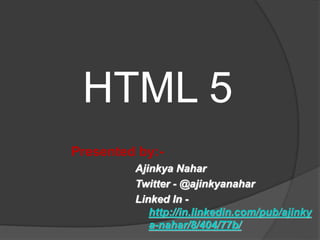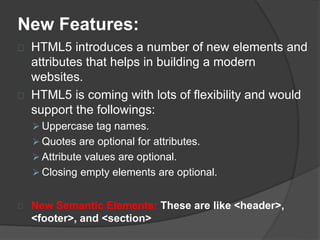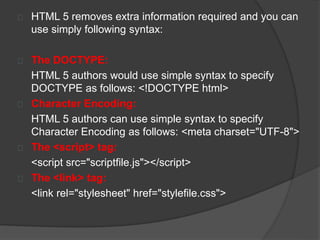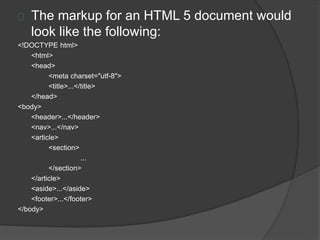Html 5
- 1. HTML 5 Presented by:- Ajinkya Nahar Twitter - @ajinkyanahar Linked In - http://in.linkedin.com/pub/ajinky a-nahar/8/404/77b/
- 2. Overview ï HTML5 is the next major revision of the HTML standard superseding HTML 4.01, XHTML 1.0, and XHTML 1.1. HTML5 is a standard for structuring and presenting content on the World Wide Web. ï The new standard incorporates features like video playback and drag-and-drop that have been previously dependent on third-party browser plug-ins such as Adobe Flash, Microsoft Silverlight, and Google Gears. ï The latest versions of Apple Safari, Google Chrome, Mozilla Firefox, and Opera all support many HTML5 features and Internet Explorer 9.0 will also have support for some HTML5 functionality. ï The mobile web browsers that come pre-installed on iPhones, iPads, and Android phones all support HTML5
- 3. New Features: ï HTML5 introduces a number of new elements and attributes that helps in building a modern websites. ï HTML5 is coming with lots of flexibility and would support the followings: ï Uppercase tag names. ï Quotes are optional for attributes. ï Attribute values are optional. ï Closing empty elements are optional. ï New Semantic Elements: These are like <header>, <footer>, and <section>
- 4. ï Server-Sent Events: HTML5 introduces events which flow from web server to the web browsers and they are called Server-Sent Events (SSE). ï Canvas: This supports a two-dimensional drawing surface that you can program with JavaScript. ï Audio & Video: You can embed audio or video on your web pages without resorting to third-party plugins. ï Geolocation: Now visitors can choose to share their physical location with your web application. ï Microdata: This lets you create your own vocabularies beyond HTML5 and extend your web pages with custom semantics. ï Drag and drop: Drag and drop the items from one location to another location on a the same webpage. ï WebSocket : A a next-generation bidirectional communication technology for web applications.
- 5. Backward Compatibility ï HTML5 is designed, as much as possible, to be backward compatible with existing web browsers. New features build on existing features and allow you to provide fallback content for older browsers. ï It is suggested to detect support for individual HTML5 features using a few lines of JavaScript. 5
- 6. ï HTML 5 removes extra information required and you can use simply following syntax: ï The DOCTYPE: HTML 5 authors would use simple syntax to specify DOCTYPE as follows: <!DOCTYPE html> ï Character Encoding: HTML 5 authors can use simple syntax to specify Character Encoding as follows: <meta charset="UTF-8"> ï The <script> tag: <script src=/slideshow/html-5-37569481/37569481/"scriptfile.js"></script> ï The <link> tag: <link rel="stylesheet" href="stylefile.css">
- 7. HTML5 Document ï The following tags have been introduced for better structure: ï section: This tag represents a generic document or application section. It can be used together with h1- h6 to indicate the document structure. ï article: This tag represents an independent piece of content of a document, such as a blog entry or newspaper article. ï aside: This tag represents a piece of content that is only slightly related to the rest of the page. ï header: This tag represents the header of a section. ï footer: This tag represents a footer for a section and can contain information about the author, copyright information, etc. 7
- 8. ï nav: This tag represents a section of the document intended for navigation. ï dialog: This tag can be used to mark up a conversation. ï figure: This tag can be used to associate a caption together with some embedded content, such as a graphic or video.
- 9. ï The markup for an HTML 5 document would look like the following: <!DOCTYPE html> <html> <head> <meta charset="utf-8"> <title>...</title> </head> <body> <header>...</header> <nav>...</nav> <article> <section> ... </section> </article> <aside>...</aside> <footer>...</footer> </body>
- 10. References - ï http://www.tutorialspoint.com/html5/ ï http://w3schools.com











